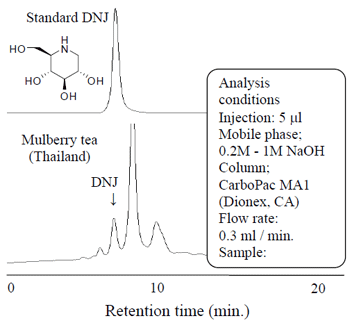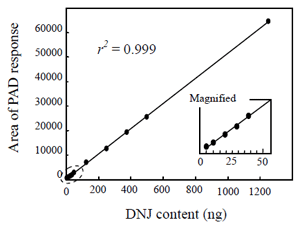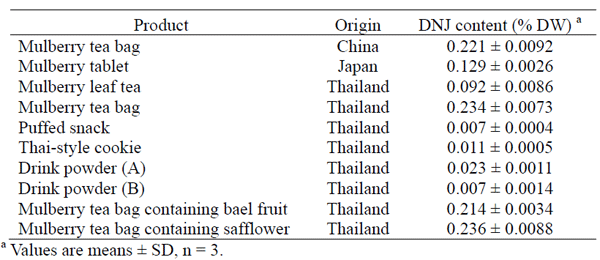Simple and Selective Quantification of 1-Deoxynojirimycin, an Antihyperglycemic Component in Foods
Description
1-Deoxynojirimycin (DNJ) occurs in mulberry or other plants and several traditional foods in Asia, such as fermented Okara (Meitaoza) in China, and is a highly potent glycosidase inhibitor reported to suppress blood glucose levels, thus preventing diabetes. Derivatization is required for quantification of DNJ upon use of spectral detection methods. Because of this difficulty, the DNJ contents of mulberry-based or DNJ-containing traditional food products are rarely established, even if DNJ is their active component.
A simple, selective and rapid method of high-performance anion-exchange chromatography with pulsed amperometric detection (HPAEC-PAD) to quantify DNJ in food products was developed. A water extract of mulberry or DNJ-containing food sample was subjected to HPAEC-PAD in a CarboPac MA1 column with a sodium hydroxide gradient of flow rate 0.3 ml / min. DNJ was clearly separated at a retention time of 7.26 min without interference and was selectively detected in the water extract. (Fig. 1) The detection limit was 5 ng and showed a wider range of quantification. (Fig. 2) Heat stability studies suggested that DNJ was heat-stable. The method was applied to various mulberry-based food products from China and Thailand, and DNJ contents were obtained as shown in Table 1.
HPAEC-PAD was not subject to interference, was highly selective for DNJ, and was superior to other HPLC techniques in terms of sample preparation, resolution, and sensitivity. The method did not require derivatization, and the chromatogram was simpler and more selective than that provided by the general detector, ELSD. The method achieved more sensitive DNJ quantification, with no obstruction of the sample matrices. Therefore, the simple, selective, and rapid analysis of DNJ in food matrices by HPAEC-PAD might be useful for the development of mulberry-based or traditional food products containing DNJ. Heat treatment could be an option for sterilizing mulberry-based products.
Figure, table
-
Fig. 1. HPAEC-PAD chromatogram of DNJ standard and mulberry tea bag from Thailand. -
Fig. 2. Calibration curve for DNJ quantification by HPAEC-PAD. -
Table 1. 1-Deoxynojirimycin (DNJ) content of mulberry leaf products in Chinese and Thai markets.
- Affiliation
-
Japan International Research Center for Agricultural Sciences Post-harvest Science and Technology Division
- Classification
-
Administration B
- Term of research
-
FY2009(FY2006~2010)
- Responsible researcher
-
YOSHIHASHI Tadashi ( Post-harvest Science and Technology Division )
Huong Do Thi Thu ( Institute of Food Research and Product Development, Kasetsart University, Thailand )
TUNGTRAKUL Patcharee ( Institute of Food Research and Product Development, Kasetsart University, Thailand )
BOONBUMRUNG Sumitra ( Institute of Food Research and Product Development, Kasetsart University, Thailand )
YAMAKI Kohji ( National Food Research Institute )
- ほか
- Publication, etc.
-
https://doi.org/10.1111/j.1750-3841.2010.01528.x
Yoshihashi et al. (2010) J. Food Sci.
- Japanese PDF



